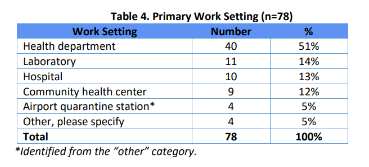Ssb
SSB USAPI_TB_07312024.docx
[NCSTLTPHIW] Information Collections to Advance State, Tribal, Local and Territorial (STLT) Governmental Agency System Performance, Capacity, and Program Delivery
SSB
OMB: 0920-0879
2024 TB Training and Education Needs Assessment – The U.S.-affiliated Pacific Islands – Online Survey
STLT Generic Information Collection Request
OMB No. 0920-0879, exp. 8/31/2026
Supporting Statement – Section B
Date: 7/31/2024
Program Official/Project Officer
Carissa Bisnath
Health Education Specialist
CDC/NCHHSTP/DTE/CEBSB/ETBS
1600 Clifton Rd Atlanta, GA 30333
404-718-6469
Table of Contents
Section B – Data collection Procedures 3
1. Respondent Universe and Sampling Methods 3
2. Procedures for the Collection of Information 3
3. Methods to Maximize Response Rates Deal with Nonresponse 4
4. Test of Procedures or Methods to be Undertaken 4
5. Individuals Consulted on Statistical Aspects and Individuals Collecting and/or Analyzing Data 4
Section B – Data collection Procedures
In the U.S.-Affiliated Pacific Islands (USAPI), health departments conduct essential public health services work for tuberculosis (TB) prevention and control in partnership with laboratories, hospitals, community health centers, airport quarantine stations, and non-governmental organizations. The health department may require collaboration from these entities to fulfill their TB prevention and control work, therefore, these entities will be considered delegates for the purposes of this submission. This is necessary to get the complete picture of training and education needs for essential TB prevention and control services conducted in the USAPI region.
The following jurisdictions will be included in the assessment: American Samoa, the Commonwealth of the Northern Mariana Islands, the Federated States of Micronesia, Guam, the Republic of Palau, and the Republic of the Marshall Islands.
A previous USAPI TB needs assessment was conducted in 2018 and we anticipate the respondent universe for the present assessment to be similar:

Data will be collected via Survey Monkey and respondents will be recruited through a notification (see Attachment B - USAPI Needs Assessment Survey Invitation Email) to the respondent universe. The notification email will explain:
The purpose of the data collection, and why their participation is important
Instructions for participating
Method to safeguard their responses
That participation is voluntary
The expected time to complete the instrument
Contact information for the project team
Participants will have 6 weeks to complete the survey. The CDC team will send out the needs assessment via the Survey Monkey link, outlining the goals/objectives of the survey and deadline for submission. Respondents will be reminded one week before the deadline to complete the survey. At the proposed deadline, participants who have been sent the survey and not completed we receive one final reminder.
Once the data collection period has ended, online survey response will be downloaded from Survey Monkey and saved on the secure CDC shared drive in a folder only accessible to DTBE staff involved in the project. The data will be cleaned and analyzed in SPSS and Excel.
Although participation in the data collection is voluntary, the project team will make every effort to maximize the rate of response. The data collection instrument was designed with particular focus on streamlining questions to allow for skipping questions based on responses to previous questions, thereby minimizing response burden.
Following the distribution of the invitation to participate in the data collection, (Attachment B - USAPI Needs Assessment Survey Invitation Email), respondents will have 30 business days to complete the instrument. Those who do not respond within 25 business days will receive a reminder (Attachment D – reminder email) urging them to complete the instrument. Those who do not respond within 5 business days from the reminder email will be considered non-responders.
The estimate for burden hours is based on a pilot test of the data collection instrument by 4 public health professionals. In the pilot test, the average time to complete the instrument including time for reviewing instructions, gathering needed information and completing the instrument, was approximately 15 minutes (range: 10 to 25 minutes). For the purposes of estimating burden hours, the upper limit of this range (i.e., 25 minutes) is used.
Carissa Bisnath
Health Education Specialist
CDC
1600 Clifton Rd. Atlanta GA 30333
404-718-6469
Elise Caruso
Behavioral Scientist
CDC
1600 Clifton Rd. Atlanta, GA 30333
404)718-6236
Megan Keaveney
Behavioral Scientist
CDC
1600 Clifton Rd. Atlanta GA 30333
770-530-8329
Nick DeLuca
Supervisory Health Education Specialist
CDC
1600 Clifton Rd. Atlanta, GA 30333
404-639-5389
Derrick Felix
Public Health Advisor
CDC
1600 Clifton Rd. Atlanta GA 30333
(404) 639-8342
LIST OF ATTACHMENTS – Section B
Note: Attachments are included as separate files as instructed.
Attachment A – USAPI Needs Assessment Survey
Attachment B – USAPI Needs Assessment Survey Invitation Email
Attachment C – Online survey
Attachment D – Reminder Email to Complete Survey
| File Type | application/vnd.openxmlformats-officedocument.wordprocessingml.document |
| Author | khx2 |
| File Modified | 0000-00-00 |
| File Created | 2024-10-28 |
© 2025 OMB.report | Privacy Policy